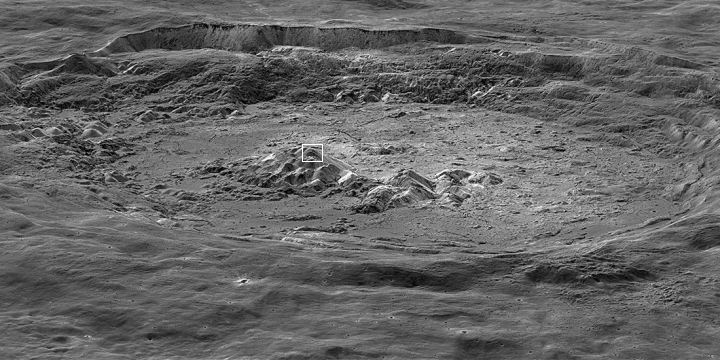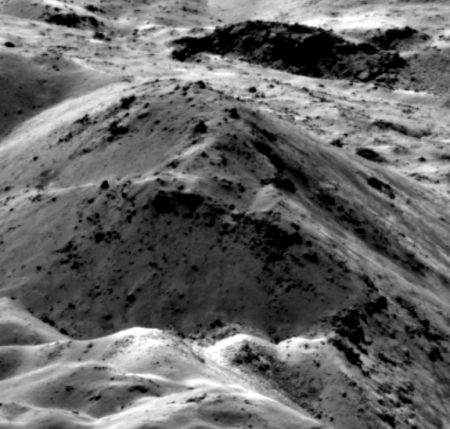Jackson Crater on the Moon’s far side


In celebration of the 50th anniversary of the Apollo 11 mission, let’s look at another cool Moon photograph. The Lunar Reconnaissance Orbiter (LRO) science team on July 19 released a new breath-taking oblique image of Jackson crater, located on the Moon’s far side. The image above, reduced significantly to post here, shows that photograph and the crater’s cluster of near-center peaks. From the caption:
East-to-west view of Jackson crater (44 miles diameter). Image was acquired when LRO was at an altitude of [69 miles] and the Sun was to the west of the crater (LROC was facing somewhat towards the Sun; phase angle 114 degrees). The central peak rises about [5900 feet] above the crater floor and the top of the crater rim in the background has more than [13,000 feet] relief relative to the floor. Image width is about [40 miles] and north is to the right
The white box indicates the area covered by the close-up to the right. From the article:
What is the composition of the crust from top to bottom? It is relatively easy to measure the surface, but what lies beneath the surface? On the Earth geologists can dig and drill deep into the crust. We do not have that luxury on the Moon, at least not yet! However, we can take advantage of natural drill holes in the crust – impact craters! When impacts occur they dig into the crust and the central peaks expose the deepest material. Jackson crater formed on what was rather uneven terrain: to the east of the crater the elevation is about +6000 meters and to the west about +3000 meters. The bottom of the crater sits at +1000 meters, and the material exposed in the central peak comes from more than 1000 meters deeper still. By studying the rocks exposed in the central peak we can get a glimpse of materials that have come up from five or more kilometers below the surface (>3 miles).
The black pile of giant boulders near the top of the close-up suggests molten material dredged up from deep below the surface. So do the many black boulders on the nearer mountain slopes.
Why this dark material does not cover the entire surface is not clear. The lighter and darker material indicates different materials and ages, but the specifics are not known, as yet.
On Christmas Eve 1968 three Americans became the first humans to visit another world. What they did to celebrate was unexpected and profound, and will be remembered throughout all human history. Genesis: the Story of Apollo 8, Robert Zimmerman's classic history of humanity's first journey to another world, tells that story, and it is now available as both an ebook and an audiobook, both with a foreword by Valerie Anders and a new introduction by Robert Zimmerman.
The print edition can be purchased at Amazon or from any other book seller. If you want an autographed copy the price is $60 for the hardback and $45 for the paperback, plus $8 shipping for each. Go here for purchasing details. The ebook is available everywhere for $5.99 (before discount) at amazon, or direct from my ebook publisher, ebookit. If you buy it from ebookit you don't support the big tech companies and the author gets a bigger cut much sooner.
The audiobook is also available at all these vendors, and is also free with a 30-day trial membership to Audible.
"Not simply about one mission, [Genesis] is also the history of America's quest for the moon... Zimmerman has done a masterful job of tying disparate events together into a solid account of one of America's greatest human triumphs."--San Antonio Express-News


In celebration of the 50th anniversary of the Apollo 11 mission, let’s look at another cool Moon photograph. The Lunar Reconnaissance Orbiter (LRO) science team on July 19 released a new breath-taking oblique image of Jackson crater, located on the Moon’s far side. The image above, reduced significantly to post here, shows that photograph and the crater’s cluster of near-center peaks. From the caption:
East-to-west view of Jackson crater (44 miles diameter). Image was acquired when LRO was at an altitude of [69 miles] and the Sun was to the west of the crater (LROC was facing somewhat towards the Sun; phase angle 114 degrees). The central peak rises about [5900 feet] above the crater floor and the top of the crater rim in the background has more than [13,000 feet] relief relative to the floor. Image width is about [40 miles] and north is to the right
The white box indicates the area covered by the close-up to the right. From the article:
What is the composition of the crust from top to bottom? It is relatively easy to measure the surface, but what lies beneath the surface? On the Earth geologists can dig and drill deep into the crust. We do not have that luxury on the Moon, at least not yet! However, we can take advantage of natural drill holes in the crust – impact craters! When impacts occur they dig into the crust and the central peaks expose the deepest material. Jackson crater formed on what was rather uneven terrain: to the east of the crater the elevation is about +6000 meters and to the west about +3000 meters. The bottom of the crater sits at +1000 meters, and the material exposed in the central peak comes from more than 1000 meters deeper still. By studying the rocks exposed in the central peak we can get a glimpse of materials that have come up from five or more kilometers below the surface (>3 miles).
The black pile of giant boulders near the top of the close-up suggests molten material dredged up from deep below the surface. So do the many black boulders on the nearer mountain slopes.
Why this dark material does not cover the entire surface is not clear. The lighter and darker material indicates different materials and ages, but the specifics are not known, as yet.
On Christmas Eve 1968 three Americans became the first humans to visit another world. What they did to celebrate was unexpected and profound, and will be remembered throughout all human history. Genesis: the Story of Apollo 8, Robert Zimmerman's classic history of humanity's first journey to another world, tells that story, and it is now available as both an ebook and an audiobook, both with a foreword by Valerie Anders and a new introduction by Robert Zimmerman.
The print edition can be purchased at Amazon or from any other book seller. If you want an autographed copy the price is $60 for the hardback and $45 for the paperback, plus $8 shipping for each. Go here for purchasing details. The ebook is available everywhere for $5.99 (before discount) at amazon, or direct from my ebook publisher, ebookit. If you buy it from ebookit you don't support the big tech companies and the author gets a bigger cut much sooner.
The audiobook is also available at all these vendors, and is also free with a 30-day trial membership to Audible.
"Not simply about one mission, [Genesis] is also the history of America's quest for the moon... Zimmerman has done a masterful job of tying disparate events together into a solid account of one of America's greatest human triumphs."--San Antonio Express-News


The dark stuff is probably from the original impact. The lighter-colored stuff that seems to have partially buried and covered some of the dark stuff – looking oddly like snowfall on Earth – is probably ejecta from later crater-forming impacts in the same general vicinity. The Lunar Farside is much more cratered than the Lunar Nearside.
Electrical discharge machining in low pressure atmospheres produces these types of features.
The moon hemorrhoids. Fine. What is coming soon? The moon boobs?